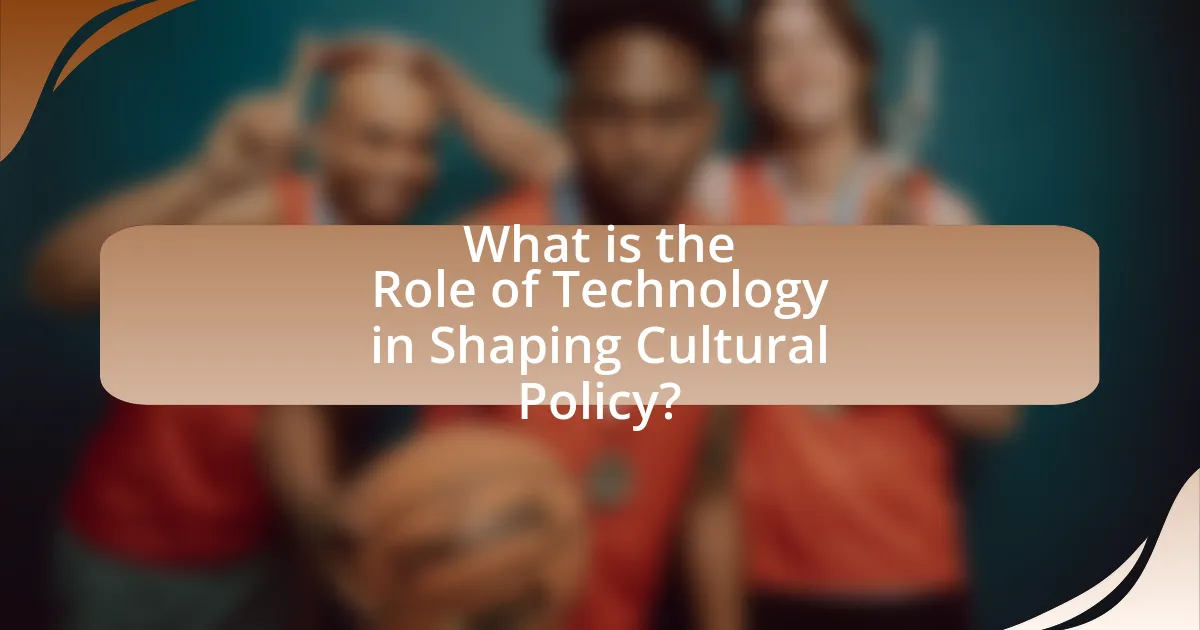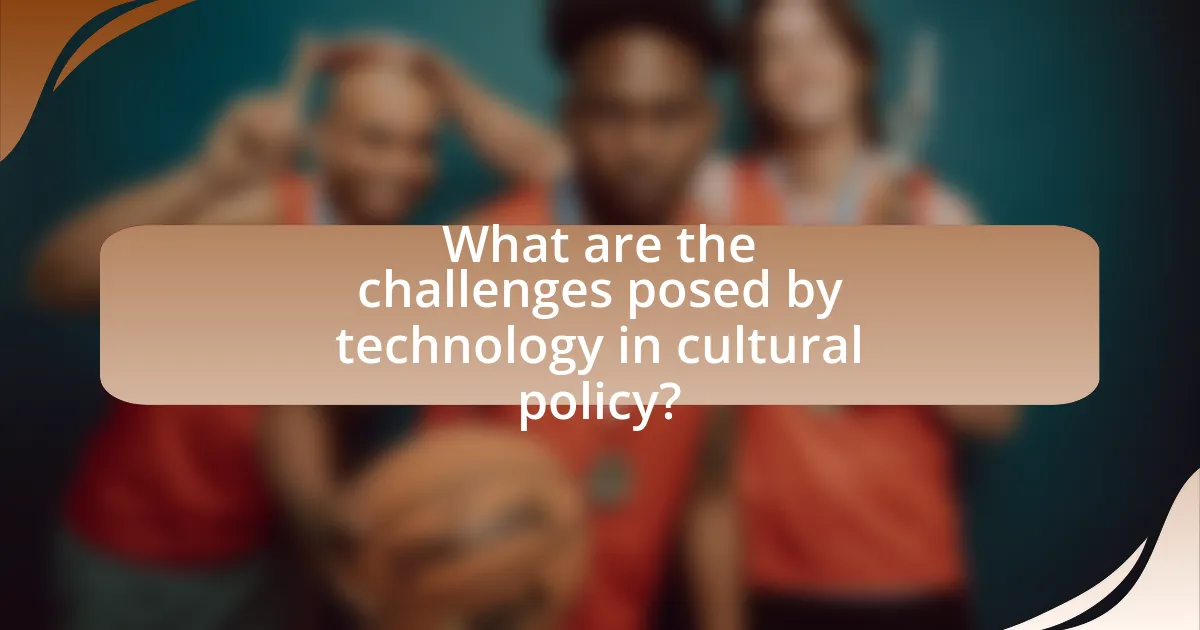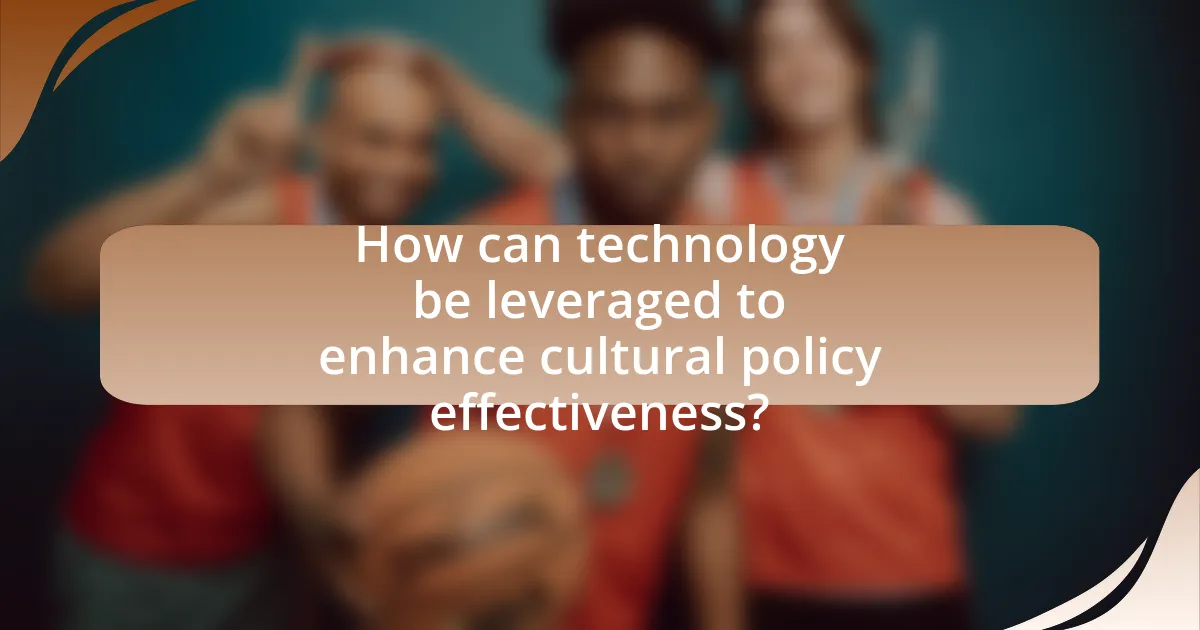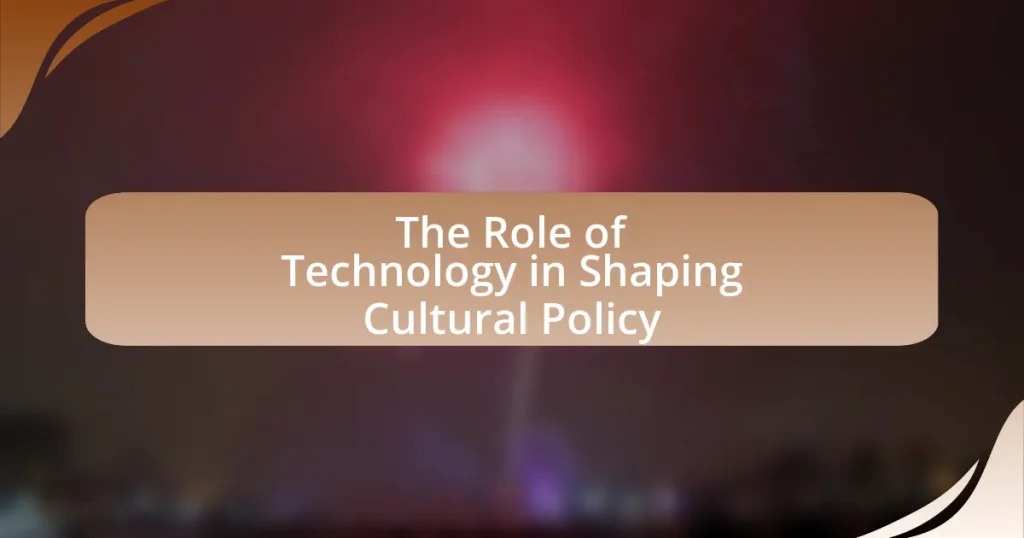The article examines the significant role of technology in shaping cultural policy, highlighting how digital platforms, data analytics, and artificial intelligence influence cultural access, expression, and preservation. It discusses the impact of technology on cultural policy development, public engagement, and representation, while also addressing challenges such as privacy concerns and the digital divide. Key advancements and their implications for cultural equity and accessibility are explored, alongside strategies for integrating technology into cultural policy effectively. The article emphasizes the necessity for policymakers to adapt to emerging technologies to enhance cultural engagement and address social inequalities.

What is the Role of Technology in Shaping Cultural Policy?
Technology plays a crucial role in shaping cultural policy by facilitating access to cultural content and enabling new forms of cultural expression. Digital platforms allow for the dissemination of diverse cultural narratives, which can influence policy decisions by highlighting underrepresented voices. For instance, social media campaigns have successfully mobilized public support for cultural initiatives, demonstrating how technology can drive policy change. Additionally, data analytics provide policymakers with insights into cultural consumption patterns, enabling more informed decisions that reflect the needs and preferences of the community. This interplay between technology and cultural policy is evident in initiatives like the European Union’s Digital Single Market, which aims to enhance access to cultural content across member states, thereby reinforcing the importance of technology in contemporary cultural policy frameworks.
How has technology influenced cultural policy development?
Technology has significantly influenced cultural policy development by enabling more efficient data collection and analysis, which informs decision-making. For instance, the rise of digital platforms has allowed policymakers to gather insights on cultural consumption patterns through analytics, leading to targeted initiatives that reflect community needs. Additionally, technology facilitates broader public engagement through social media, allowing diverse voices to contribute to cultural discussions and policy formation. This shift is evident in the adoption of digital tools by cultural institutions, which have expanded access to cultural resources and increased participation in cultural activities.
What are the key technological advancements impacting cultural policy?
Key technological advancements impacting cultural policy include digital platforms, data analytics, and artificial intelligence. Digital platforms, such as social media and streaming services, have transformed how cultural content is distributed and consumed, influencing policy decisions regarding copyright and access. Data analytics enables policymakers to understand audience preferences and trends, allowing for more informed cultural funding and programming decisions. Artificial intelligence is increasingly used in curating content and personalizing user experiences, raising questions about cultural representation and bias in policy frameworks. These advancements necessitate ongoing adaptation of cultural policies to address the evolving landscape of technology and its implications for cultural expression and access.
How do digital platforms alter the landscape of cultural policy?
Digital platforms significantly alter the landscape of cultural policy by democratizing access to cultural content and enabling diverse voices to be heard. These platforms, such as social media and streaming services, allow creators to distribute their work without traditional gatekeepers, thereby influencing policy decisions related to copyright, funding, and cultural representation. For instance, the rise of platforms like YouTube has led to discussions about fair compensation for creators and the need for regulations that protect intellectual property while fostering innovation. Additionally, data analytics from these platforms inform policymakers about audience preferences and trends, shaping cultural initiatives and funding allocations.
Why is understanding technology’s role in cultural policy important?
Understanding technology’s role in cultural policy is important because it influences how cultural content is created, distributed, and consumed. Technology shapes access to cultural resources, enabling diverse voices and perspectives to emerge while also posing challenges such as digital divides and misinformation. For instance, the rise of social media platforms has transformed cultural engagement, allowing for real-time interaction and feedback, which can enhance community involvement in cultural policy decisions. Additionally, data analytics can inform policymakers about audience preferences and trends, leading to more effective cultural initiatives. Thus, recognizing technology’s impact is crucial for developing inclusive and adaptive cultural policies that reflect contemporary societal dynamics.
What implications does technology have for cultural preservation?
Technology significantly enhances cultural preservation by enabling the digitization and archiving of cultural artifacts, practices, and languages. This process allows for the safeguarding of cultural heritage against loss due to natural disasters, neglect, or globalization. For instance, UNESCO’s Memory of the World program highlights the importance of digitizing historical documents and artifacts, which can be accessed globally, ensuring that diverse cultures are represented and preserved. Additionally, technologies such as virtual reality and augmented reality provide immersive experiences that allow individuals to engage with cultural heritage in innovative ways, fostering greater appreciation and understanding. The use of social media platforms also facilitates the sharing and promotion of cultural practices, enabling communities to maintain their cultural identity in a rapidly changing world.
How does technology affect cultural accessibility and participation?
Technology significantly enhances cultural accessibility and participation by providing diverse platforms for engagement and dissemination of cultural content. Digital tools, such as social media, streaming services, and virtual reality, allow individuals from various backgrounds to access cultural experiences that were previously limited by geographical or economic barriers. For instance, a report by the National Endowment for the Arts in 2020 indicated that online arts engagement increased by 50% during the COVID-19 pandemic, demonstrating how technology can facilitate participation in cultural activities. Furthermore, technology enables the creation of inclusive content, catering to different languages and disabilities, thereby broadening participation across diverse demographics.

What are the challenges posed by technology in cultural policy?
Technology poses several challenges in cultural policy, primarily including issues of accessibility, preservation, and the digital divide. Accessibility challenges arise as not all populations have equal access to technology, which can lead to cultural exclusion. Preservation of cultural heritage becomes difficult as digital formats may not be sustainable long-term, risking the loss of important cultural artifacts. Additionally, the digital divide exacerbates inequalities, as marginalized communities may lack the resources to engage with or benefit from technological advancements in cultural policy. These challenges necessitate careful consideration and strategic planning to ensure that technology serves to enhance rather than hinder cultural engagement and preservation.
How do privacy concerns intersect with cultural policy and technology?
Privacy concerns significantly intersect with cultural policy and technology by influencing regulations that govern data usage and protection. As technology advances, cultural policies must adapt to address the implications of data collection and surveillance on individual privacy rights. For instance, the General Data Protection Regulation (GDPR) in the European Union exemplifies how cultural policy can enforce strict data protection measures, reflecting societal values regarding privacy. This regulation impacts technology companies by requiring them to implement privacy-by-design principles, thereby shaping how technology is developed and deployed in cultural contexts. Additionally, public discourse around privacy often informs cultural policy decisions, as communities advocate for stronger protections against invasive technologies, illustrating the dynamic relationship between privacy, culture, and technological advancement.
What are the risks of data misuse in cultural policy frameworks?
Data misuse in cultural policy frameworks poses significant risks, including the potential for discrimination, loss of privacy, and erosion of public trust. Discrimination can occur when data is used to favor certain cultural groups over others, leading to unequal access to resources and opportunities. Loss of privacy arises when personal data is collected and utilized without consent, compromising individuals’ rights. Erosion of public trust happens when stakeholders perceive that data is being mismanaged or exploited, which can diminish community engagement and support for cultural initiatives. These risks highlight the need for robust data governance and ethical standards in cultural policy development.
How can cultural institutions address these privacy challenges?
Cultural institutions can address privacy challenges by implementing robust data protection policies and utilizing encryption technologies. These measures ensure that personal information collected from visitors is securely stored and processed, thereby minimizing the risk of data breaches. For instance, the General Data Protection Regulation (GDPR) mandates that organizations must obtain explicit consent from individuals before collecting their data, which cultural institutions can adopt to enhance privacy compliance. Additionally, training staff on privacy best practices and regularly auditing data handling processes can further strengthen their commitment to protecting visitor information.
What role does technology play in cultural equity?
Technology plays a crucial role in promoting cultural equity by providing platforms for diverse voices and facilitating access to cultural resources. It enables marginalized communities to share their narratives and engage with broader audiences through social media, digital storytelling, and online cultural archives. For instance, the rise of platforms like YouTube and Instagram has allowed underrepresented artists to showcase their work globally, bypassing traditional gatekeepers in the art and media industries. Additionally, initiatives such as the Digital Public Library of America enhance access to cultural heritage materials, ensuring that diverse histories are preserved and accessible to all. This democratization of cultural expression and access is essential for fostering cultural equity.
How can technology bridge gaps in cultural representation?
Technology can bridge gaps in cultural representation by enabling diverse voices to be heard and facilitating access to cultural content across various platforms. Digital tools, such as social media and streaming services, allow marginalized communities to share their narratives and experiences, which can counteract historical underrepresentation. For instance, platforms like YouTube and TikTok have empowered creators from different cultural backgrounds to reach global audiences, fostering greater understanding and appreciation of diverse cultures. Additionally, data analytics can help organizations identify gaps in representation and tailor content to reflect a broader spectrum of cultural identities, ensuring that cultural policies are inclusive and representative of society’s diversity.
What strategies can be employed to ensure equitable access to cultural resources?
To ensure equitable access to cultural resources, strategies such as implementing digital platforms, enhancing community engagement, and providing targeted funding can be employed. Digital platforms, like online archives and virtual museums, allow broader access to cultural materials, overcoming geographical barriers. Community engagement initiatives, such as workshops and outreach programs, foster local participation and ensure that diverse voices are represented in cultural narratives. Additionally, targeted funding for underrepresented communities can help support cultural projects that reflect their unique heritage and needs, as evidenced by programs like the National Endowment for the Arts’ initiatives aimed at minority groups, which have successfully increased access to cultural resources.

How can technology be leveraged to enhance cultural policy effectiveness?
Technology can be leveraged to enhance cultural policy effectiveness by utilizing data analytics, digital platforms, and communication tools to inform decision-making and engage communities. Data analytics allows policymakers to assess cultural participation trends and identify gaps in access, enabling targeted interventions. Digital platforms facilitate broader outreach and participation, ensuring diverse voices are included in cultural discussions. Communication tools enhance collaboration among stakeholders, fostering a more inclusive policy development process. For instance, the use of social media has been shown to increase public engagement in cultural initiatives, as evidenced by the National Endowment for the Arts’ reports on community engagement strategies.
What innovative tools are available for cultural policy analysis?
Innovative tools available for cultural policy analysis include data visualization software, social media analytics platforms, and geographic information systems (GIS). Data visualization software, such as Tableau, enables policymakers to interpret complex datasets visually, facilitating better decision-making. Social media analytics platforms, like Brandwatch, allow for the analysis of public sentiment and trends related to cultural policies, providing real-time feedback on community engagement. Geographic information systems (GIS), such as ArcGIS, help in mapping cultural resources and demographics, allowing for spatial analysis of cultural policy impacts. These tools enhance the ability to assess and adapt cultural policies effectively based on empirical data and community needs.
How can data analytics improve decision-making in cultural policy?
Data analytics can significantly enhance decision-making in cultural policy by providing evidence-based insights that inform strategies and resource allocation. By analyzing data on cultural participation, demographics, and economic impact, policymakers can identify trends and needs within communities. For instance, a study by the National Endowment for the Arts found that data-driven approaches led to more targeted funding and programming, resulting in increased public engagement and satisfaction. This demonstrates that leveraging data analytics not only optimizes cultural investments but also aligns them with the actual preferences and behaviors of the population, ultimately leading to more effective cultural policies.
What role do social media platforms play in shaping public cultural discourse?
Social media platforms significantly influence public cultural discourse by providing a space for diverse voices and facilitating rapid information exchange. These platforms enable users to share opinions, cultural expressions, and social movements, which can lead to shifts in public perception and cultural norms. For instance, the #MeToo movement gained momentum through social media, highlighting issues of sexual harassment and leading to widespread cultural conversations and policy changes. Additionally, studies show that social media can amplify marginalized voices, allowing for a broader representation of cultural narratives. This dynamic interaction shapes societal values and influences cultural policy by reflecting and responding to public sentiment.
What best practices should be adopted for integrating technology into cultural policy?
Best practices for integrating technology into cultural policy include fostering collaboration between cultural institutions and tech companies, ensuring accessibility and inclusivity in digital platforms, and utilizing data analytics to inform decision-making. Collaboration allows for innovative solutions that enhance cultural experiences, as seen in partnerships like the Smithsonian Institution’s collaboration with Google Arts & Culture, which expanded access to art and history. Accessibility ensures that diverse audiences can engage with cultural content, supported by initiatives such as the National Endowment for the Arts’ focus on digital equity. Data analytics provides insights into audience preferences and engagement, enabling policymakers to tailor cultural offerings effectively, as demonstrated by the use of audience data in programming decisions by organizations like the Los Angeles County Museum of Art.
How can cultural policymakers stay updated with technological trends?
Cultural policymakers can stay updated with technological trends by actively engaging in continuous education and networking within the tech community. This includes attending industry conferences, participating in workshops, and subscribing to relevant publications that focus on technology’s impact on culture. For instance, events like South by Southwest (SXSW) and the International Conference on Cultural Policy Research provide platforms for policymakers to learn about emerging technologies and their applications in cultural contexts. Additionally, collaboration with tech experts and organizations can facilitate knowledge exchange, ensuring that policymakers are informed about the latest advancements and their implications for cultural policy.
What collaborative approaches can enhance technology’s role in cultural policy?
Collaborative approaches that can enhance technology’s role in cultural policy include partnerships between government agencies, cultural institutions, and technology companies. These collaborations can facilitate the development of digital platforms that promote cultural heritage and accessibility. For instance, initiatives like the Europeana project, which aggregates cultural heritage content from various institutions across Europe, demonstrate how collaboration can leverage technology to enhance public access to cultural resources. Additionally, co-creation workshops involving artists, technologists, and policymakers can lead to innovative solutions that address cultural needs while utilizing emerging technologies, such as virtual reality and artificial intelligence, to engage wider audiences.
What are the future trends in technology and cultural policy?
Future trends in technology and cultural policy include the integration of artificial intelligence in content creation and curation, as well as the increased emphasis on digital equity and access. As AI technologies advance, they will play a significant role in shaping cultural narratives and influencing public policy decisions, evidenced by initiatives like the European Union’s Digital Services Act, which aims to regulate online platforms and protect users. Additionally, the focus on digital equity is driven by the need to ensure that all communities have access to technology and cultural resources, as highlighted by reports from organizations such as the Pew Research Center, which indicate disparities in technology access among different demographic groups. These trends reflect a broader shift towards leveraging technology to enhance cultural engagement while addressing social inequalities.
How might emerging technologies redefine cultural engagement?
Emerging technologies are redefining cultural engagement by facilitating more interactive and immersive experiences. For instance, virtual reality (VR) and augmented reality (AR) allow users to engage with cultural artifacts and environments in ways that were previously impossible, enhancing accessibility and participation. A study by the Pew Research Center in 2021 found that 72% of cultural institutions reported using digital tools to reach wider audiences, demonstrating a significant shift in how cultural content is consumed and shared. Additionally, social media platforms enable real-time interaction and community building around cultural events, further transforming traditional engagement methods.
What potential developments should cultural policymakers anticipate?
Cultural policymakers should anticipate the integration of advanced technologies such as artificial intelligence, virtual reality, and blockchain into cultural sectors. These technologies are expected to enhance audience engagement, streamline funding processes, and improve access to cultural resources. For instance, AI can analyze audience preferences to tailor cultural offerings, while virtual reality can create immersive experiences that attract diverse demographics. Additionally, blockchain technology can ensure transparency in funding and ownership rights, which is crucial for artists and cultural institutions. As these technologies evolve, policymakers must adapt regulations and support systems to foster innovation while preserving cultural heritage.










